Winter in Oregon brings a lively spectacle of feathered visitors. Across the state, various avian species migrate from colder regions, seeking refuge and sustenance during this season.
From snow-capped mountains to wetlands and coastal areas, Oregon offers a variety of habitats that attract an array of winter birds.
Whether it’s witnessing the elegant flight of Tundra Swans, spotting the bustling Northern Flickers, or marvelling at the vibrant plumage of Western Bluebirds, bird enthusiasts and nature lovers alike are treated to a delightful display of winged wonders during the winter months.
This introduction will explore some of the fascinating winter bird species that grace the landscapes of Oregon, painting a vivid picture of the intricate harmony between nature and its avian inhabitants.
20 Winter Birds In Oregon
Oregon is home to a diverse range of bird species, and during the winter months, you can observe various migratory birds and resident species. Here is a list of 51 winter birds commonly found in Oregon:
1. Dark-Eyed Junco (Junco hyemalis)
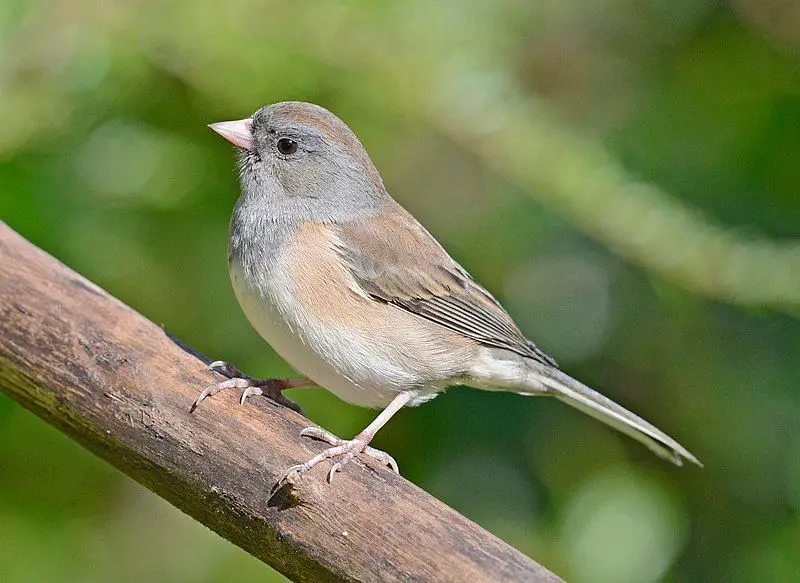
The Dark-Eyed Junco, classified as Junco hyemalis, is a small, migratory sparrow found across North America.
Recognized for its distinctive colouration, it sports slate-grey bodies, white underparts, and a contrasting dark hood or “eyebrow,” varying slightly among regional subspecies.
These sparrows frequent woodlands, gardens, and suburban areas. They are ground-feeding birds, often foraging for seeds on the forest floor.
Their melodious trill and adaptability make them a favourite among bird enthusiasts. Dark-eyed juncos migrate seasonally, covering a vast range from Alaska to the southern United States.
| Kingdom | Animalia |
| Phylum | Chordata |
| Clade | Dinosauria |
| Class | Aves |
| Order | Passeriformes |
| Family | Passerellidae |
| Genus | Junco |
| Species | J. hyemalis |
2. Song Sparrow (Melospiza melodia)
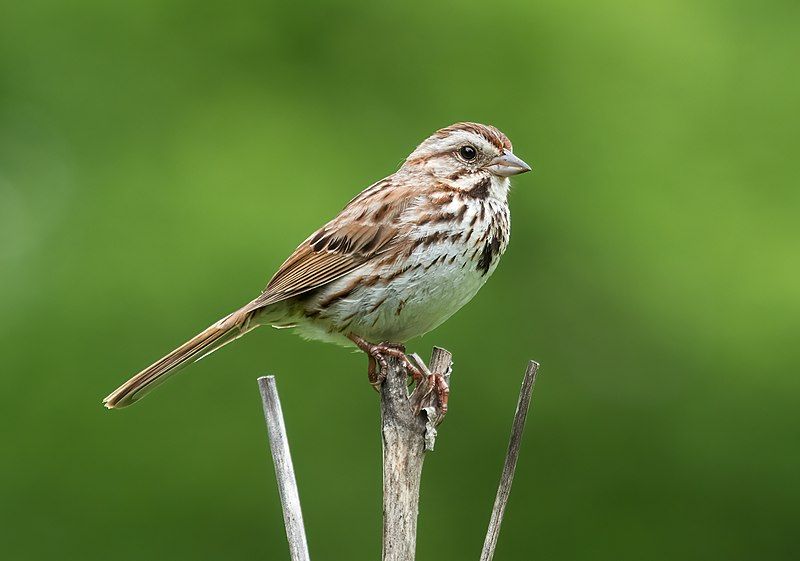
The Song Sparrow, scientifically known as Melospiza melodia, is a versatile North American bird renowned for its melodious and intricate songs. Its brownish plumage features streaks on the breast and a distinct central spot.
Song Sparrows are adaptable, thriving in various habitats, from gardens to marshes. They feed on insects, seeds, and berries, constructing cup-shaped nests in low vegetation.
While some populations remain year-round, others migrate seasonally. The Song Sparrow’s captivating song, characterized by regional variations, adds charm to gardens, parks, and wetlands throughout its extensive range.
| Kingdom | Animalia |
| Phylum | Chordata |
| Clade | Dinosauria |
| Class | Aves |
| Order | Passeriformes |
| Family | Passerellidae |
| Genus | Melospiza |
| Species | M. melodia |
3. Golden-Crowned Sparrow (Zonotrichia atricapilla)
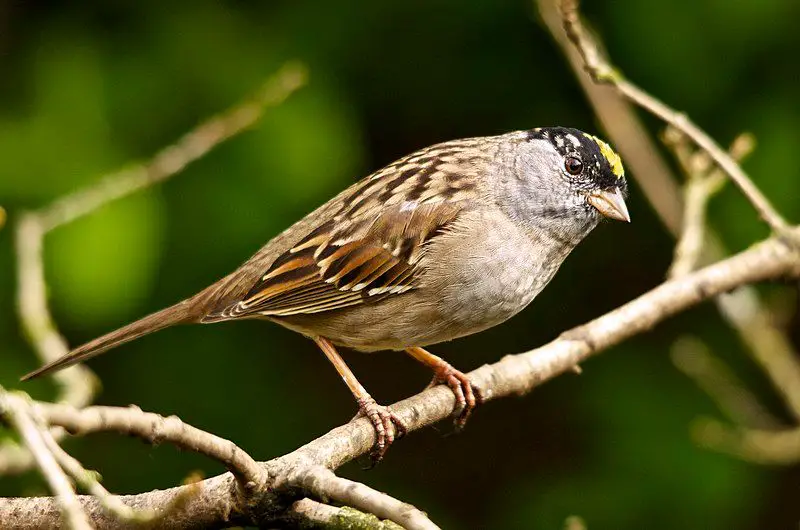
The Golden-Crowned Sparrow, scientifically designated as Zonotrichia atricapilla, is a striking sparrow native to western North America.
It stands out with a vibrant yellow crown stripe atop its head, complementing its brownish-grey plumage adorned with streaks.
These sparrows prefer brushy habitats, forest edges, and open areas, primarily consuming seeds and insects.
Golden-crowned sparrows are migratory, wintering in coastal regions and breeding in the northern United States and Canada.
Their melodious song enriches the soundscape of the Pacific Northwest during the breeding season, making them a treasured presence in the region’s avian biodiversity.
| Kingdom | Animalia |
| Phylum | Chordata |
| Clade | Dinosauria |
| Class | Aves |
| Order | Passeriformes |
| Family | Passerellidae |
| Genus | Zonotrichia |
| Species | Z. atricapilla |
4. House Finch (Haemorhous mexicanus)
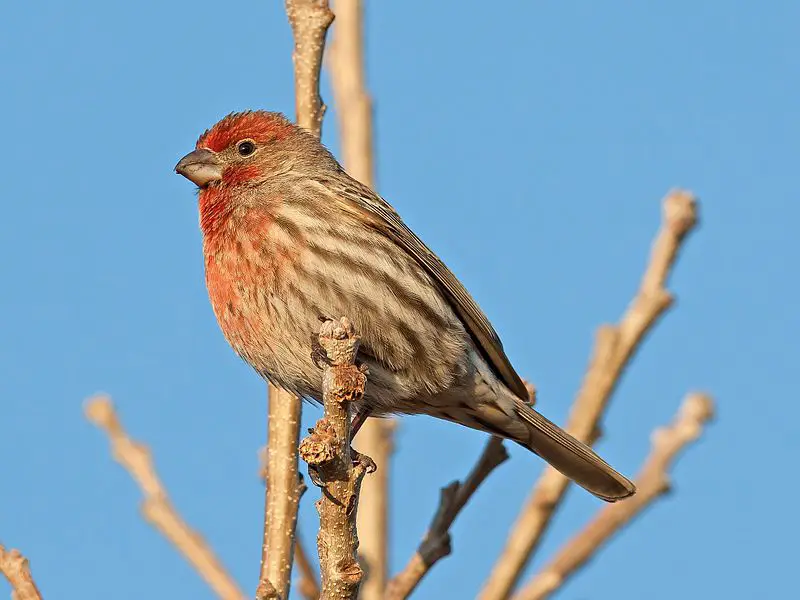
The House Finch, scientifically known as Haemorhous mexicanus, is a small passerine bird found across North America. These finches are known for their adaptability and vibrant plumage.
Male House Finches display red plumage on their heads, throats, and chests, though the intensity varies based on diet. They thrive in diverse habitats, from urban areas to open woodlands.
House Finches primarily feed on seeds, making them frequent visitors to bird feeders. They construct cup-shaped nests in various locations, including building ledges and hanging planters.
Their melodious songs, a series of twittering notes, are common in suburban settings.
| Kingdom | Animalia |
| Phylum | Chordata |
| Clade | Dinosauria |
| Class | Aves |
| Order | Passeriformes |
| Family | Fringillidae |
| Genus | Haemorhous |
| Species | H. mexicanus |
5. Anna’s Hummingbird (Calypte anna)
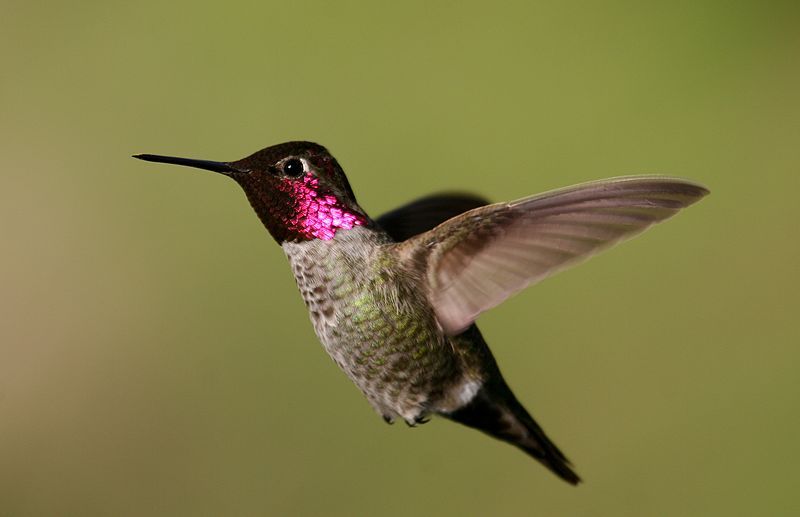
Anna’s Hummingbird, scientifically named Calypte anna, is a stunning and resilient species found along the western coast of North America.
These small, iridescent birds feature vibrant green plumage, with males displaying striking rose-red throats.
Anna’s Hummingbirds are known for their year-round presence in mild climates, thanks to their ability to withstand cold temperatures.
They feed on nectar from flowers and are frequent visitors to hummingbird feeders. These agile birds perform impressive aerial displays, producing distinctive squeaky sounds during courtship.
Their adaptability and remarkable beauty make them a favourite among bird enthusiasts in their range.
| Kingdom | Animalia |
| Phylum | Chordata |
| Clade | Strisores |
| Class | Aves |
| Order | Apodiformes |
| Family | Trochilidae |
| Genus | Calypte |
| Species | C. anna |
6. Juncos (Junco spp.)
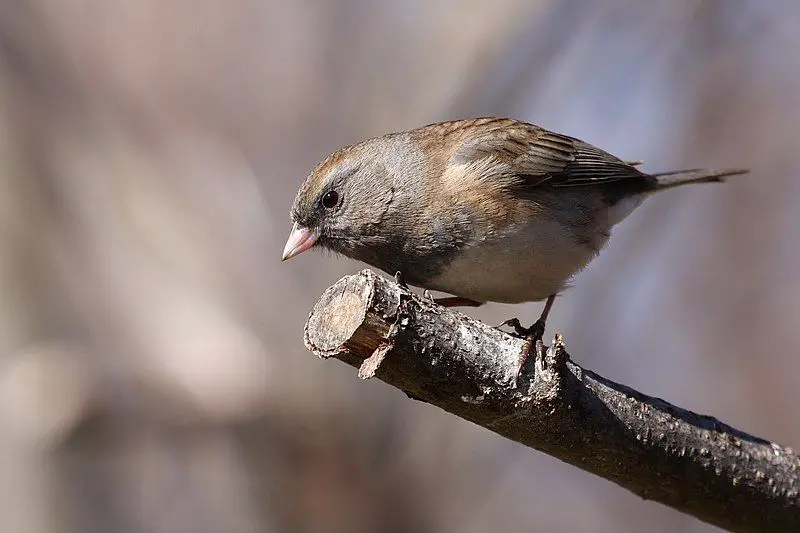
Juncos are a group of small, ground-feeding sparrows from the Junco genus. These birds are collectively called “Juncos” and are found across North America, with several regional subspecies.
They typically have slate-grey bodies, white underparts, and varying degrees of dark head plumage. Juncos are migratory, with their range extending from Alaska to the southern United States.
They often forage for seeds on the forest floor and are known for their trilling songs. Their adaptability to different habitats and distinctive appearance make them a common and cherished sight in many areas.
| Kingdom | Animalia |
| Phylum | Chordata |
| Clade | Dinosauria |
| Class | Aves |
| Order | Passeriformes |
| Family | Passerellidae |
| Genus | Junco |
7. Northern Flicker (Colaptes auratus)
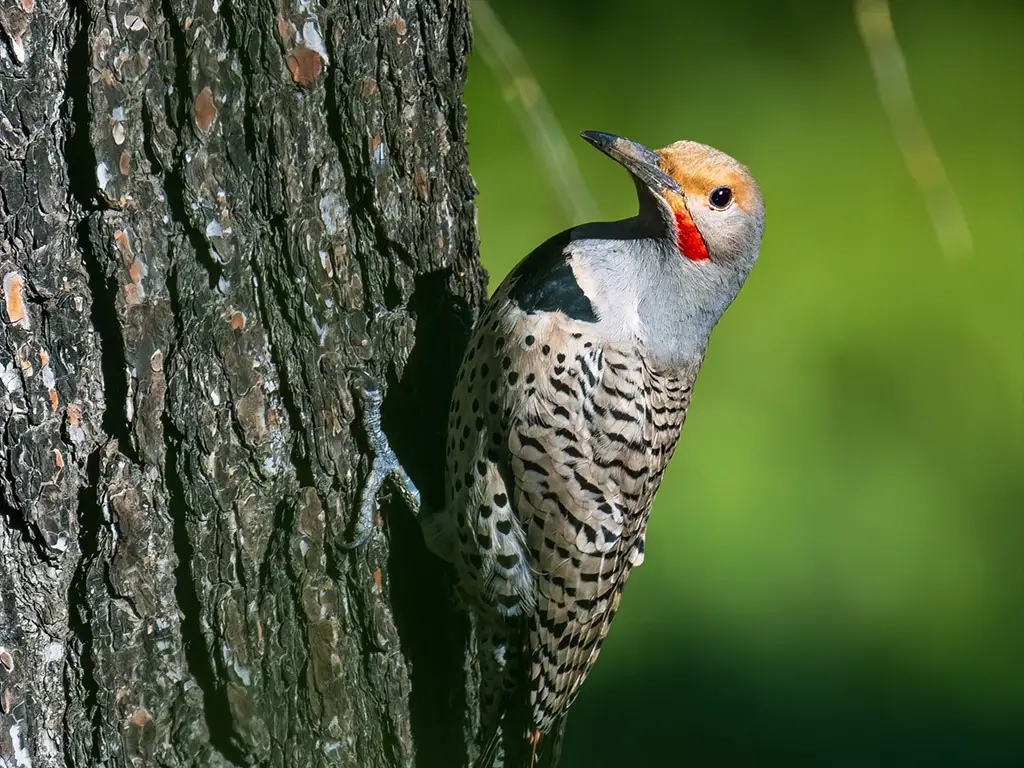
The Northern Flicker, scientifically known as Colaptes auratus, is a medium-sized woodpecker found throughout North America. These distinctive woodpeckers have brown plumage with black markings, and their undersides are speckled.
Northern Flickers are unique among woodpeckers, often foraging on the ground for ants and beetles. Their call is a distinctive “wick-a-wick-a-wick” sound.
They build nests in tree cavities and can also be found in urban areas. Some subspecies, like the Yellow-shafted Flicker and Red-shafted Flicker, have regional colour variations in their plumage.
| Kingdom | Animalia |
| Phylum | Chordata |
| Clade | Dinosauria |
| Class | Aves |
| Order | Piciformes |
| Family | Picidae |
| Genus | Colaptes |
| Species | C. auratus |
8. Black-Capped Chickadee (Poecile atricapillus)
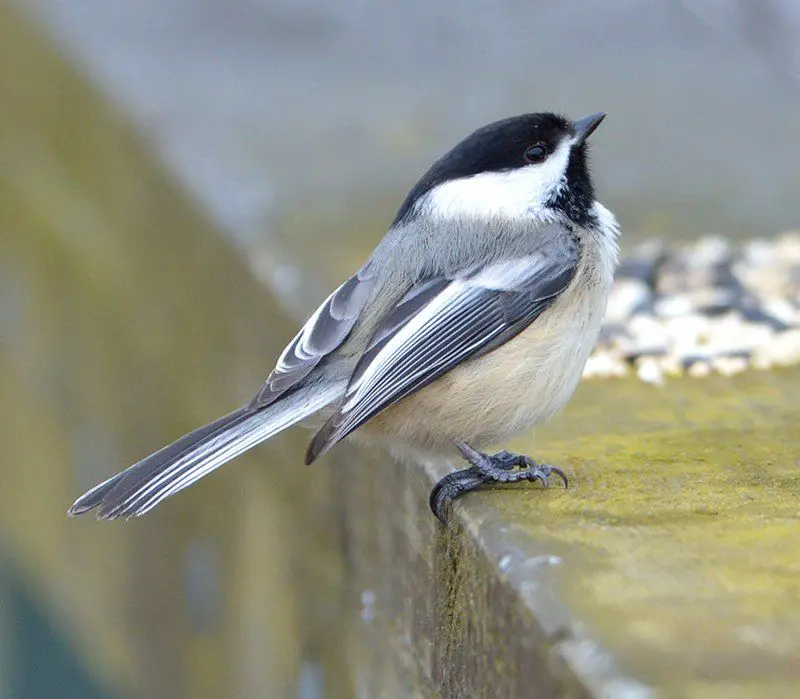
The Black-Capped Chickadee, scientifically known as Poecile atricapillus, is a charming and widespread songbird found in North America. These small birds are easily recognized by their black caps and throats, contrasting with their white cheeks and grey wings.
They inhabit various forested habitats, often visiting bird feeders for seeds and suet. Chickadees are known for their distinctive “chick-a-dee-dee-dee” call, which varies in intensity depending on the threat level from predators.
They build cup-shaped nests in tree cavities and are admired for their friendly and inquisitive nature, making them a beloved species among birdwatchers.
| Kingdom | Animalia |
| Phylum | Chordata |
| Clade | Dinosauria |
| Class | Aves |
| Order | Passeriformes |
| Family | Paridae |
| Genus | Poecile |
| Species | P. atricapillus |
9. House Sparrow (Passer domesticus)
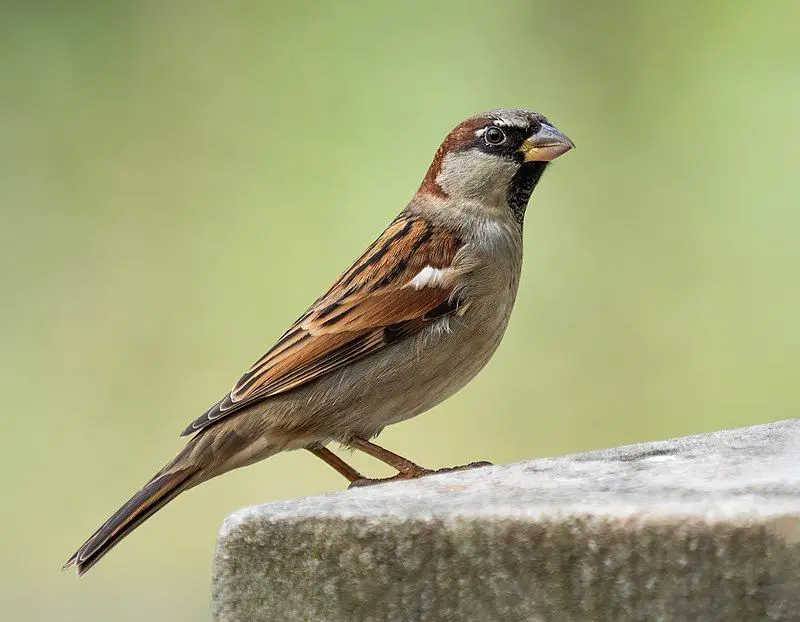
The House Sparrow, scientifically named Passer domesticus, is a small passerine bird that has adapted to human settlements worldwide. These birds are known for their distinctive brown plumage with streaks and the males’ black bib.
House Sparrows are highly adaptable and thrive in urban and suburban environments. They primarily feed on seeds, grains, and insects. Their cheerful chirping and chattering are common sounds in many neighbourhoods.
They build nests in cavities and crevices, including buildings and trees. Despite being introduced to various regions, House Sparrows are declining in some areas due to habitat changes.
Nevertheless, they remain among the most familiar and widespread bird species globally.
| Kingdom | Animalia |
| Phylum | Chordata |
| Clade | Dinosauria |
| Class | Aves |
| Order | Passeriformes |
| Family | Passeridae |
| Genus | Passer |
| Species | P. domesticus |
10. California Scrub Jay (Aphelocoma californica)
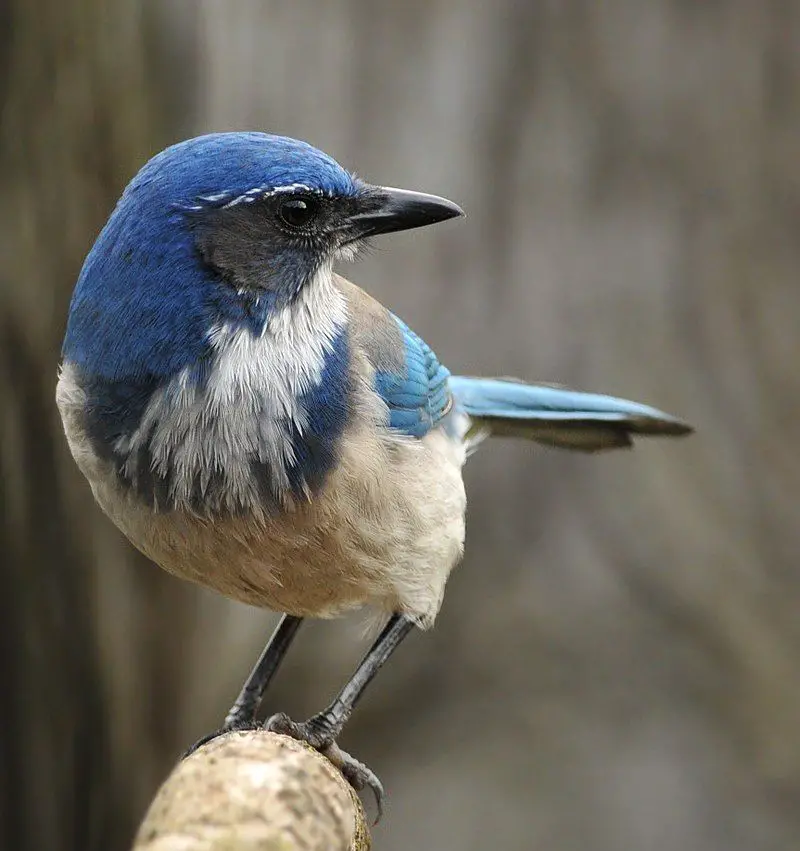
The California Scrub Jay, or Aphelocoma californica, is a striking bird native to western North America. These jays are known for their bold blue plumage, a crest atop their heads, and a white throat patch.
They inhabit a range of habitats, from oak woodlands to suburban gardens. California Scrub Jays are omnivorous, feeding on a varied diet of insects, acorns, fruits, and even small vertebrates.
They are intelligent and often stash food items in caches for later consumption, contributing to forest regeneration through seed dispersal. Their harsh, raucous calls and vibrant appearance make them conspicuous in their range.
| Kingdom | Animalia |
| Phylum | Chordata |
| Clade | Dinosauria |
| Class | Aves |
| Order | Passeriformes |
| Family | Corvidae |
| Genus | Aphelocoma |
| Species | A. californica |
11. American Sparrows (Genus Passerella and others)
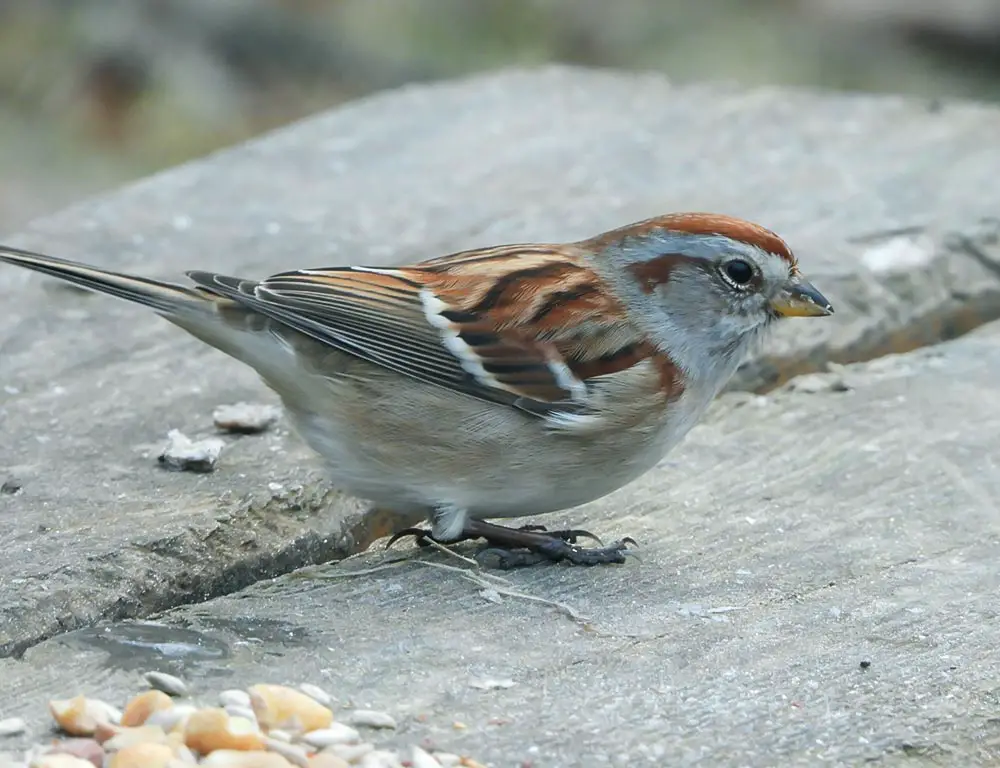
American Sparrows encompass diverse sparrows, including various species within the Passerella genus, such as Fox Sparrows, and others like the Chipping Sparrow and Savannah Sparrow.
These sparrows are found across North America, each with its unique characteristics.
For instance, Fox Sparrows are known for their richly coloured plumage and melodious songs, while Chipping Sparrows are recognized for their rusty crowns.
American Sparrows are seed-eating birds, often seen foraging on the ground. Their subtle beauty and melodious calls contribute to the avian diversity of their respective regions.
12. White-Crowned Sparrow (Zonotrichia leucophrys)
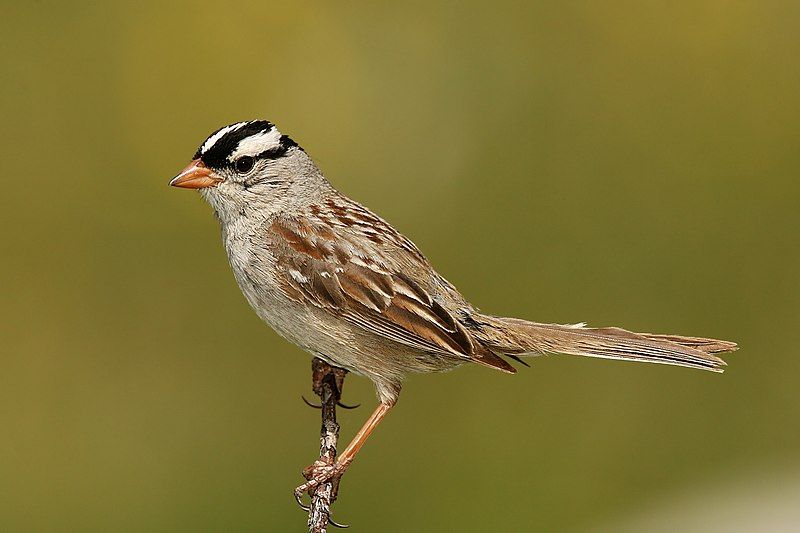
The White-Crowned Sparrow, scientifically known as Zonotrichia leucophrys, is a distinctive bird with its striking black-and-white striped crown, white underparts, and greyish-brown wings. They have a sweet, clear song and are found throughout North America.
White-Crowned Sparrows occupy various habitats, including shrublands, grasslands, and woodlands. They primarily feed on seeds, berries, and insects. These sparrows build cup-shaped nests in shrubs and low vegetation.
They are migratory birds, with some populations wintering in the southern United States and others breeding in northern regions. Their bold head markings and lovely songs make them a favourite among birdwatchers.
| Kingdom | Animalia |
| Phylum | Chordata |
| Clade | Dinosauria |
| Class | Aves |
| Order | Passeriformes |
| Family | Passerellidae |
| Genus | Zonotrichia |
| Species | Z. leucophrys |
13. Steller’s Jay (Cyanocitta stelleri)
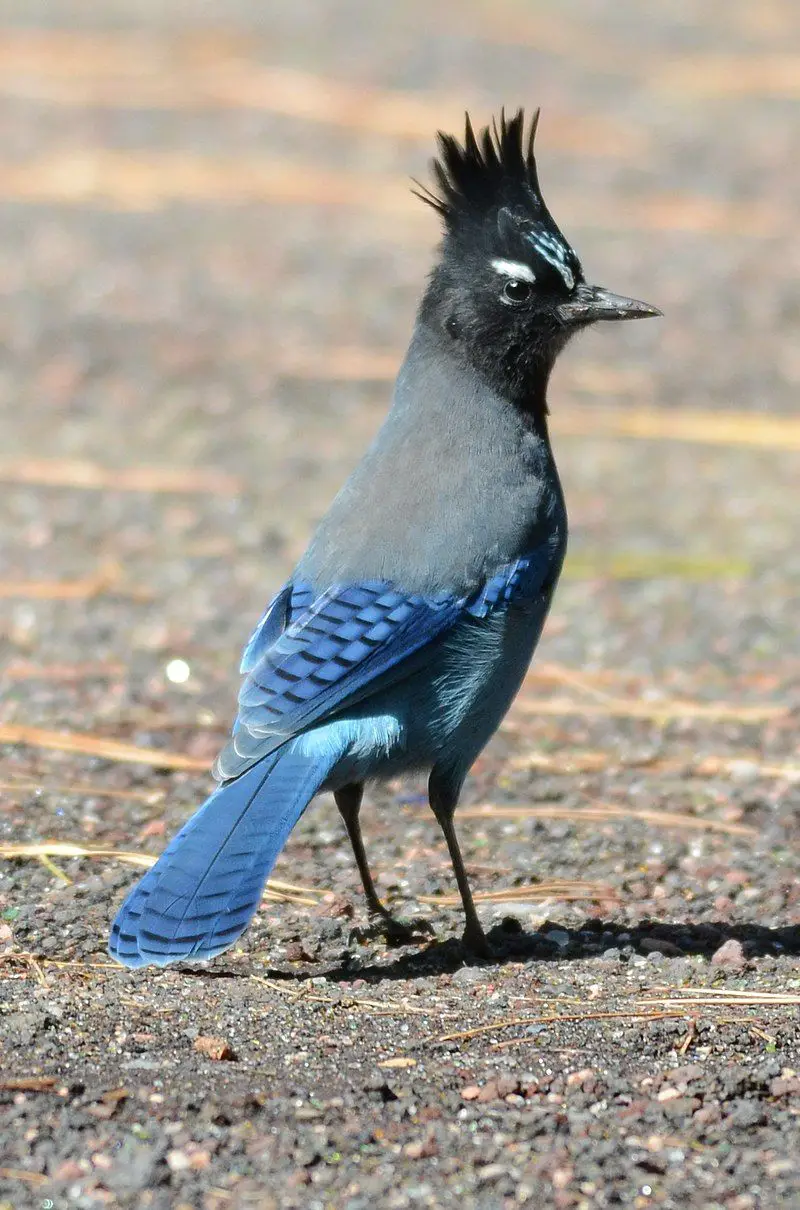
| Kingdom | Animalia |
| Phylum | Chordata |
| Clade | Dinosauria |
| Class | Aves |
| Order | Passeriformes |
| Family | Corvidae |
| Genus | Cyanocitta |
| Species | C. stelleri |
14. Ruby-Crowned Kinglet (Regulus calendula)
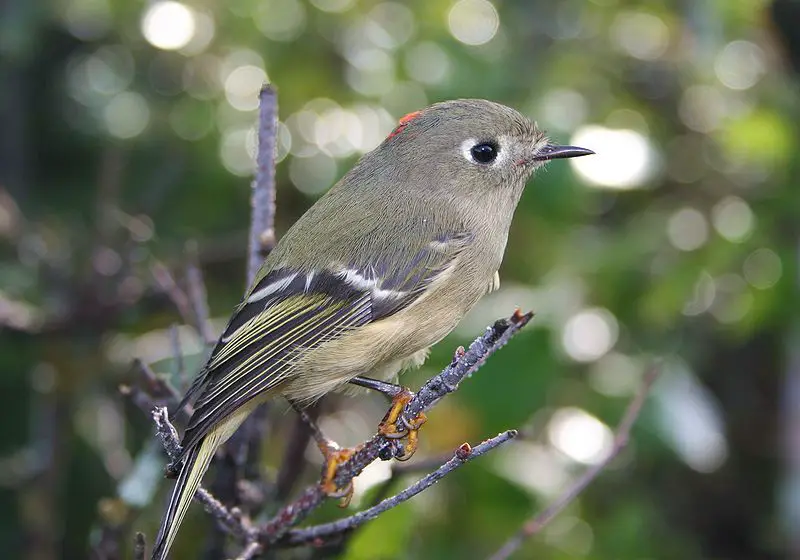
The Ruby-Crowned Kinglet, scientifically known as Regulus calendula, is a tiny, hyperactive bird found throughout North America. It gets its name from the inconspicuous ruby-red crown patch on the top of its head, which is rarely displayed.
These kinglets are known for their constant flitting and rapid movements as they search for insects and spiders among trees and foliage. They have olive-green plumage with white eye-rings.
Ruby-crowned kinglets are migratory birds, nesting in boreal forests and wintering in more temperate regions. Their high-pitched, tinkling song is a delightful sound in woodlands during the breeding season.
| Kingdom | Animalia |
| Phylum | Chordata |
| Clade | Dinosauria |
| Class | Aves |
| Order | Passeriformes |
| Family | Regulidae |
| Genus | Corthylio |
| Species | C. calendula |
15. Red-Breasted Nuthatch (Sitta canadensis):
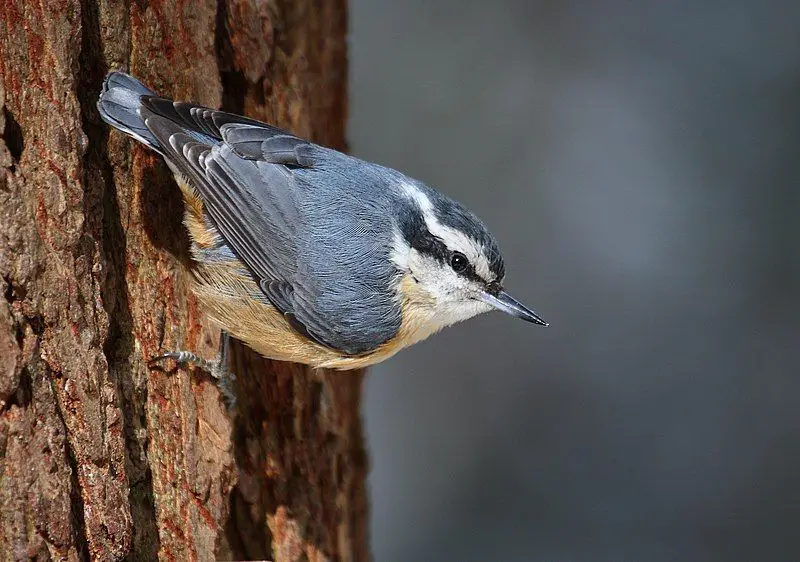
The Red-Breasted Nuthatch, or Sitta canadensis, is a charming bird found in North America’s coniferous forests. They are easily recognized by their blue-grey plumage, white face, and distinctive reddish-orange breast.
These nuthatches are skilled climbers and are often seen crawling headfirst down tree trunks in search of insects and seeds. Their nasal, tinny calls are a common woodland sound.
Red-breasted nuthatches are year-round residents in many regions, and they often visit bird feeders to enjoy sunflower seeds and suet. Their agility, striking appearance, and acrobatic foraging habits make them a favourite among birdwatchers.
| Kingdom | Animalia |
| Phylum | Chordata |
| Clade | Dinosauria |
| Class | Aves |
| Order | Passeriformes |
| Family | Sittidae |
| Genus | Sitta |
| Species | S. canadensis |
16. Bewick’s Wren (Thryomanes bewickii)
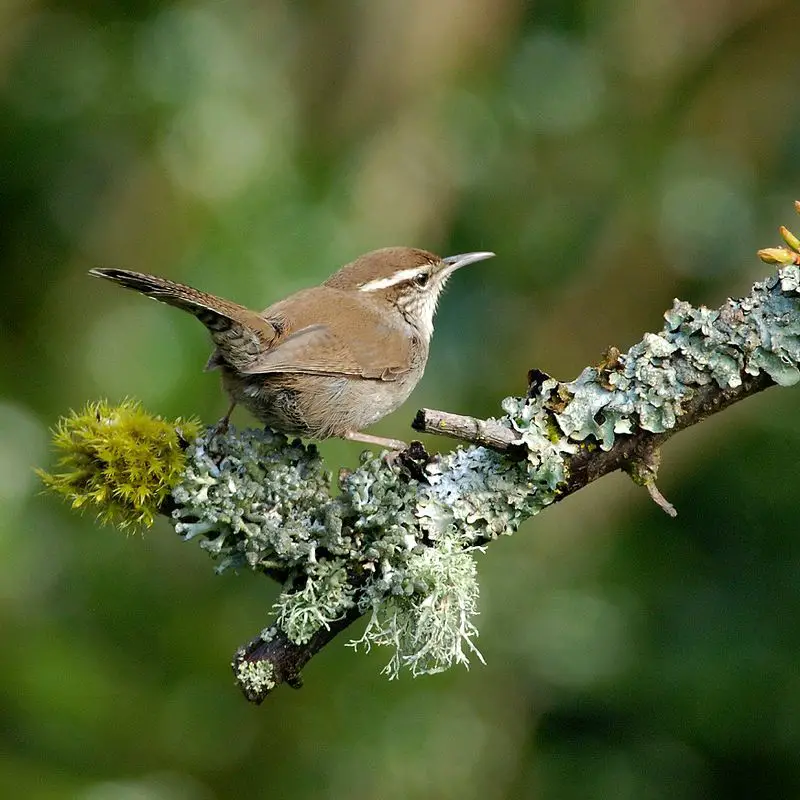
Bewick’s Wren, scientifically referred to as Thryomanes bewickii, is a small, songful bird native to North America. These wrens are known for their pale brown plumage, distinctive white eyebrows, and long, curved bills.
They inhabit a variety of environments, from open woodlands to shrubby areas. Bewick’s Wrens are expert insect foragers, utilizing their long bills to probe crevices for prey.
They construct intricate, dome-shaped nests with entrance tunnels, often tucked away in shrubs or vegetation.
Their melodious and complex songs are a highlight of spring and summer in their range, consisting of a series of cheerful, trilling notes. Bewick’s Wrens are cherished for their lively nature and beautiful songs.
| Kingdom | Animalia |
| Phylum | Chordata |
| Clade | Dinosauria |
| Class | Aves |
| Order | Passeriformes |
| Family | Troglodytidae |
| Genus | Thryomanes |
| Species | T. bewickii |
17. American Robin (Turdus migratorius)
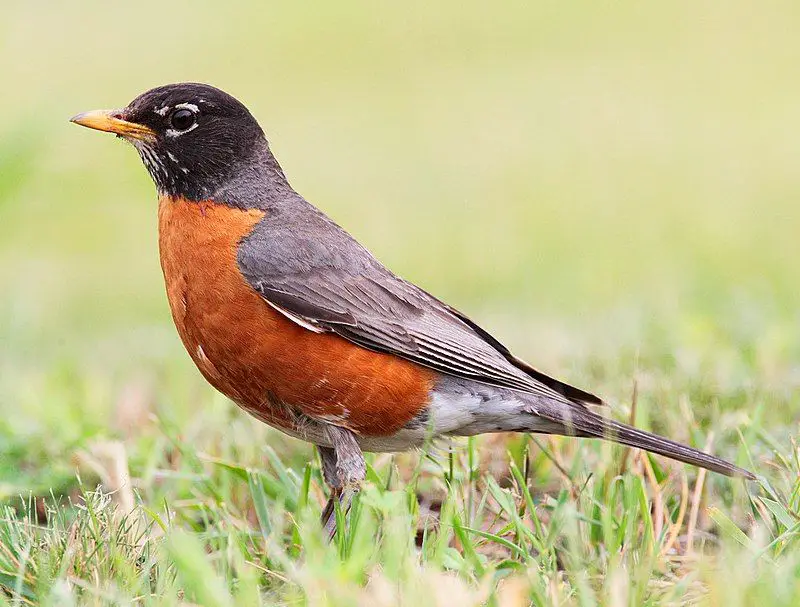
The American Robin, scientifically known as Turdus migratorius, is an iconic bird in North America. Recognizable by their rusty-orange breast, greyish back, and white eye-ring, these birds are heralds of spring.
They are known for their cheerful, melodious song, often associated with the arrival of warmer weather. American Robins forage for earthworms, insects, and berries in yards, parks, and open woodlands.
They build cup-shaped nests in trees and shrubs, and they are year-round residents in many regions. American Robins are a symbol of renewal and are among the first birds to sing at dawn, filling the air with their joyful tunes.
| Kingdom | Animalia |
| Phylum | Chordata |
| Clade | Dinosauria |
| Class | Aves |
| Order | Passeriformes |
| Family | Turdidae |
| Genus | Turdus |
| Species | T. migratorius |
18. American Goldfinch (Spinus tristis)
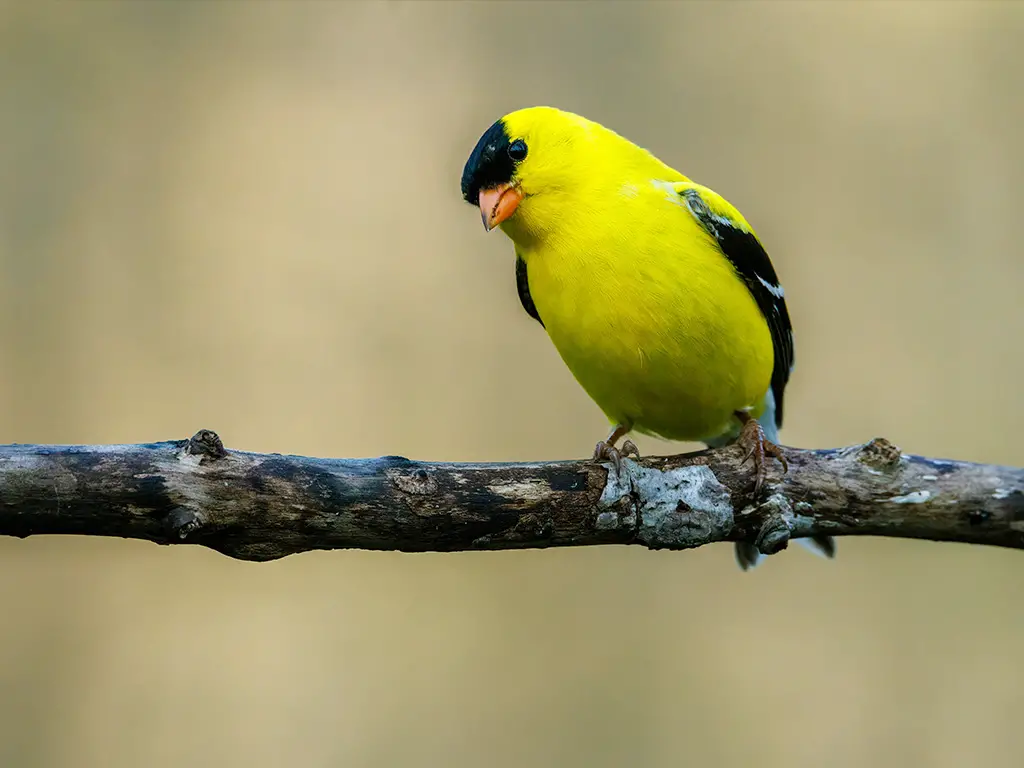
The American Goldfinch, scientifically referred to as Spinus tristis, is a small, vibrant bird native to North America. These finches are known for their bright yellow plumage, which intensifies during the breeding season.
They inhabit meadows, fields, and gardens, often seen perched on thistle plants while feeding on seeds. American Goldfinches are strict vegetarians, primarily consuming seeds like sunflower and thistle.
They build nests in shrubs and trees, incorporating thistles into their construction. During the breeding season, males sing a cheerful, bubbling song.
These finches are highly gregarious and are a delightful sight in gardens and open habitats throughout their range.
| Kingdom | Animalia |
| Phylum | Chordata |
| Clade | Dinosauria |
| Class | Aves |
| Order | Passeriformes |
| Family | Fringillidae |
| Genus | Spinus |
| Species | S. tristis |
19. Chestnut-Backed Chickadee (Poecile rufescens)
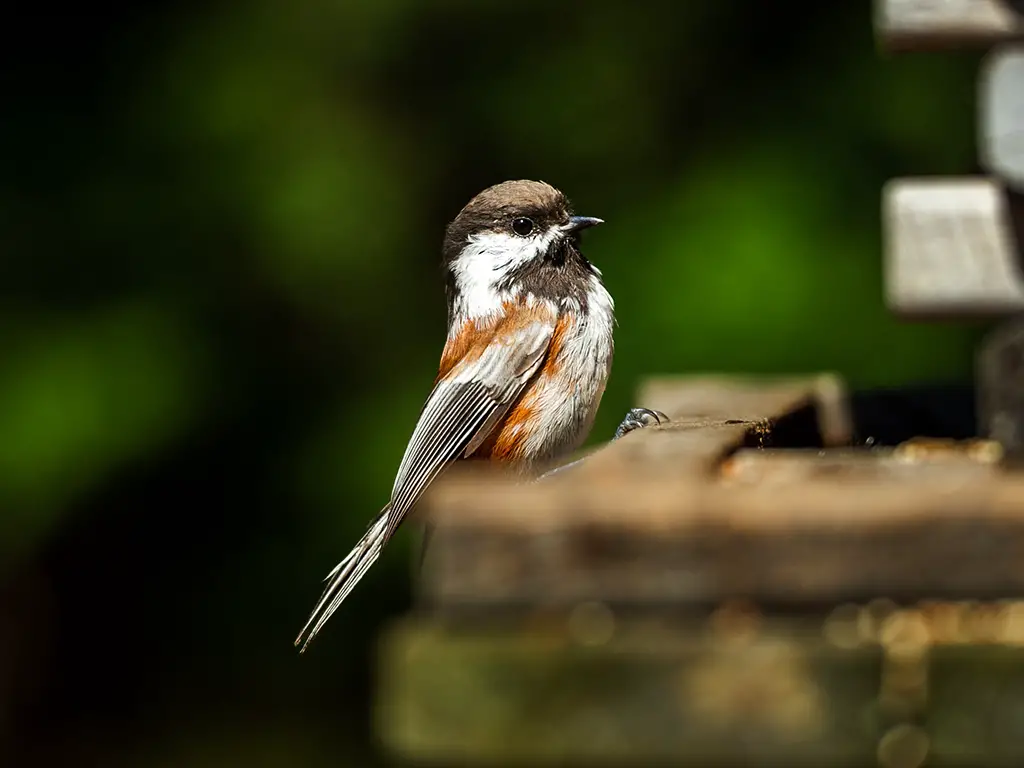
The Chestnut-Backed Chickadee, scientifically known as Poecile rufescens, is a charming bird found in the western parts of North America. They have a distinctive chestnut-coloured back, with grey wings, a black cap, and a white face.
Chestnut-backed chickadees are known for their energetic and inquisitive nature. They often visit bird feeders and forage for insects and seeds in coniferous forests.
These chickadees construct cup-shaped nests in tree cavities and are year-round residents in their range.
Their cheerful “chick-a-dee-dee-dee” call and active behaviour make them popular among bird enthusiasts in the Pacific Northwest.
| Kingdom | Animalia |
| Phylum | Chordata |
| Clade | Dinosauria |
| Class | Aves |
| Order | Passeriformes |
| Family | Paridae |
| Genus | Poecile |
| Species | P. rufescens |
20. Yellow-Rumped Warbler (Setophaga coronata)
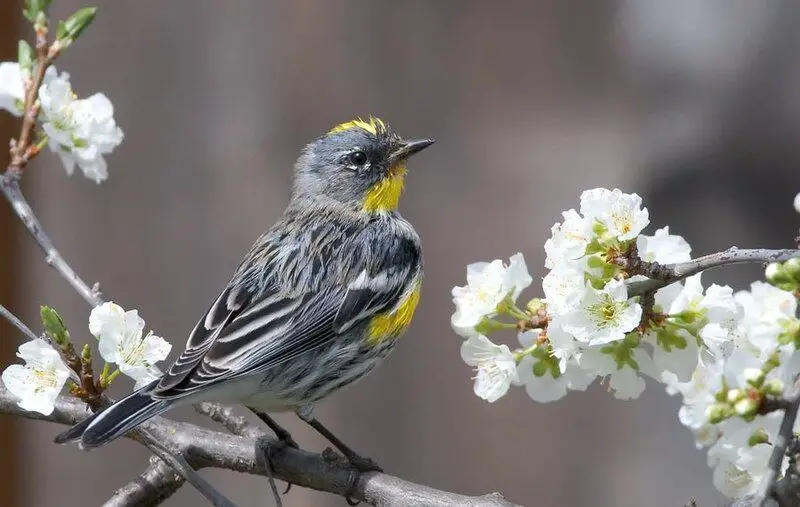
The Yellow-Rumped Warbler, scientifically referred to as Setophaga coronata, is a well-known warbler species in North America. They have a striking appearance, with yellow patches on their rump, sides, and crown, along with a white throat and greyish wings.
These warblers are highly adaptable and can be found in various habitats, from woodlands to suburban gardens. They primarily feed on insects and berries.
The Yellow-Rumped Warbler is recognized by its distinctive “chip” call and its ability to switch between various foraging techniques.
During the breeding season, males sing a musical trill. They are a common sight during migration, adding colour and vitality to the avian landscape.
| Kingdom | Animalia |
| Phylum | Chordata |
| Clade | Dinosauria |
| Class | Aves |
| Order | Passeriformes |
| Family | Parulidae |
| Genus | Setophaga |
| Species | S. coronata |
Conclusion
Oregon is a fantastic destination for birdwatching enthusiasts during the winter months. With its diverse habitats, mild climate, and abundant food sources, the state attracts various winter birds.
From regal raptors like bald eagles and peregrine falcons to charming songbirds like the dark-eyed junco and cedar waxwing, Oregon offers a unique and rewarding birdwatching experience.
Whether exploring coastal areas, wetlands, or mountain regions, visitors can witness the fascinating behaviours and vibrant plumages of these winter residents.
As conservation efforts continue to protect and restore bird habitats across the state, Oregon remains a vital sanctuary for both resident and migratory winter birds. So, grab your binoculars and join the awe-inspiring world of winter birdwatching in beautiful Oregon.